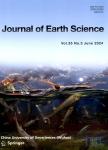A Study on the Genetic Dynamics and Development Characteristics of Granitic Rock Avalanches in the Northern Qinling Mountains, China
作者机构:College of Geological Engineering and Geomatics, Chang'an University Institute of Geosafety, China University of GeosciencesBeijing
出 版 物:《Journal of Earth Science》 (地球科学学刊)
年 卷 期:2024年
核心收录:
学科分类:08[工学] 0837[工学-安全科学与工程]
基 金:financially supported by the National Natural Science Foundation of China (Grant Nos. 41672285,42207197,42293350 and 42293355) Fundamental Research Funds for the Central Universities,CHD (Grant No. 300102262908)
摘 要:Massive granitic rock avalanches are extensively developed in the middle section of the northern Qinling Mountains (NQM), China. The current consensus is that their formation could have been connected with seismic events that occurred in the NQM. However, there is a lack of systematic discussion on the genetic dynamics of these rock avalanches. Hence, taking Earth system scientific research as a starting point, this paper systematically summarizes and discusses development characteristics, formation times and genetic dynamic mechanisms of granitic rock avalanches in the NQM based on geological investigations, high-precision remote sensing interpretations, geomorphological dating, geophysical exploration, and a large-scale shaking table model test. We identified 53 granitic rock avalanches in this area, with a single collapse area ranging from 0.01×106to 1.71×106m2. Their development time can be divided into six stages, namely, 107297~106289 years BP, 11870-11950 years BP, 11666~10279 years BP, 2260-2320 years BP, 1788-1925 years BP, and 1392~1661 years BP, which were closely related to multiple prehistoric or ancient earthquakes. We suggest that long-term coupling of internal and external earth dynamics was responsible for the granitic rock avalanches in the NQM; the internal dynamics were mainly related to subduction, collision and extrusion of different plates under the Qinling terrane, leading to the formation and tectonic uplift of the Qinling orogenic belt; and the external dynamics were closely associated with climate changes resulting in mountain denudation, freeze-thaw cycles and isostatic balance uplift. In this process, the formation and evolution of the Qinling orogenic belt play a geohazard-pregnant role, structural planes, including faults and joints, play a geohazard-controlled role, and earthquakes play a geohazard-induced role, which jointly results in the occurrence of large-scale granitic rock avalanches in the NQM. This research can not only decip



